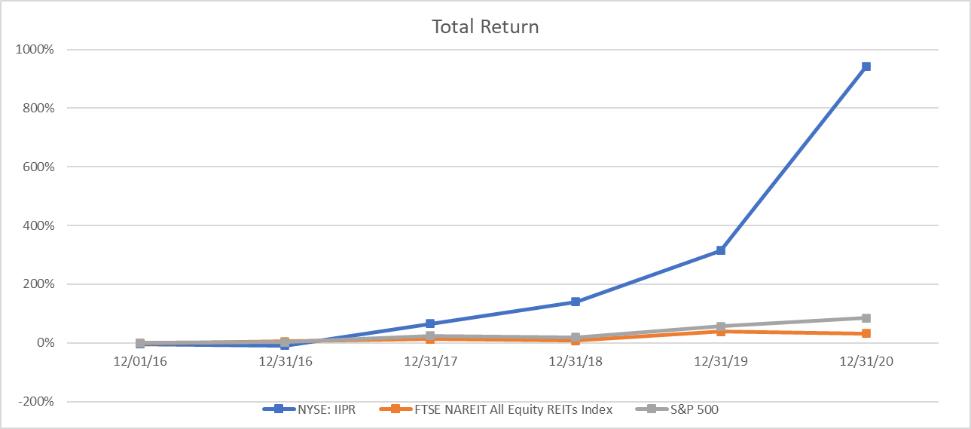particular contract. If both conditions are present, the lease amendment is accounted for as a new lease that is separate from the original lease.
NaN of our leases that was entered into prior to 2019 provides the lessee with a purchase option to purchase the leased property at the end of the initial lease term in September 2034, subject to the satisfaction of certain conditions. The purchase option provision allows the lessee to purchase the leased property at the greatest of (a) the fair value; (b) the value determined by dividing the then-current base rent by 8%; and (c) an amount equal to our gross investment in the property (including the purchase price at acquisition and any additional investment in the property made by us during the term of the lease), indexed to inflation. At December 31, 2020, our gross investment in the property with the purchase option was approximately $30.5 million. At December 31, 2020, the purchase option was not exercisable.
Our leases generally contain options to extend the lease terms at the prevailing market rate at the time of expiration. Certain of our leases provide the lessee with a right of first refusal or right of first offer in the event we market the leased property for sale.
Recent Accounting Pronouncements. In June 2016, the FASB issued ASU 2016-13, Financial Instruments — Credit Losses, which changes the impairment model for most financial assets and certain other instruments. For trade and other receivables, held-to-maturity debt securities, loans and other instruments, companies will be required to use a new forward-looking “expected loss” model that generally will result in the earlier recognition of allowances for losses. In November 2018, the FASB issued ASU 2018-19, Codification Improvements to Topic 326, Financial Instruments — Credit Losses, which among other updates, clarifies that receivables arising from operating leases are not within the scope of this guidance and should be evaluated in accordance with Topic 842. For available-for-sale debt securities with unrealized losses, companies will measure credit losses in a manner similar to what they do today, except that the losses will be recognized as allowances rather than as reductions in the amortized cost of the securities. These standards were effective for the Company on January 1, 2020 and did not have a material impact on our consolidated financial statements.
In August 2020, the FASB issued ASU 2020-06, Debt — Debt with Conversion and Other Options (Subtopic 470-20) and Derivatives and Hedging—Contracts in Entity’s Own Equity (Subtopic 815-40): Accounting for Convertible Instruments and Contracts in an Entity’s Own Equity. ASU 2020-06 simplifies the accounting for convertible debt by eliminating the beneficial conversion and cash conversion accounting models. ASU 2020-06 also updates the earnings per share calculation and requires entities to assume share settlement when the convertible debt can be settled in cash or shares. ASU 2020-06 is effective for fiscal years beginning after December 15, 2021 and is to be adopted through a cumulative-effect adjustment to the opening balance of retained earnings either at the date of adoption or in the first comparative period presented. Upon adoption of ASU 2020-06, convertible debt proceeds, unless issued with a substantial premium or an embedded conversion feature, will no longer be allocated between debt and equity components. This will reduce the issue discount and result in less non-cash interest expense in our consolidated financial statements. Additionally, ASU 2020-06 will result in the reporting of a diluted earnings per share, if the effect is dilutive, in our consolidated financial statements, regardless of our settlement intent.
Concentration of Credit Risk. As of December 31, 2020, we owned 66 properties located in Arizona, California, Colorado, Florida, Illinois, Maryland, Massachusetts, Michigan, Minnesota, Nevada, New Jersey, New York, North Dakota, Ohio, Pennsylvania, Virginia, and Washington. The ability of any of our tenants to honor the terms of its lease is dependent upon the economic, regulatory, competition, natural and social factors affecting the community in which that tenant operates. NaN of our tenants, PharmaCann Inc. (“PharmaCann”) (at 5 of our properties), Ascend Wellness Holdings, LLC (“Ascend”) (at 3 of our properties), and Cresco Labs, LLC (“Cresco”) (at 5 of our properties), represented approximately 18%, 10%, and 10%, respectively, of our rental revenues (including tenant reimbursements) for the year ended December 31, 2020. NaN of our tenants, PharmaCann (at 5 of our properties) and Ascend (at two of our properties), represented approximately 26% and 12%, respectively, of our rental revenues (including tenant reimbursements) for the year ended December 31, 2019. NaN of our tenants, PharmaCann (at 2 of our properties), Holistic Industries, Inc. (“Holistic”) (at 1 property), Vireo Health, Inc. (“Vireo”) (at 3 properties), and The Pharm, LLC (“The Pharm”) (at 1 property), represented approximately 38%, 18%, 16% and 16%, respectively, of our rental revenues (including tenant reimbursements) for the year ended December 31, 2018.
At December 31, 2020, none of our properties individually represented more than 5% of our net real estate held for investment. At December 31, 2019, 1 of our properties in New York accounted for 6% of our net real estate held for investment.
